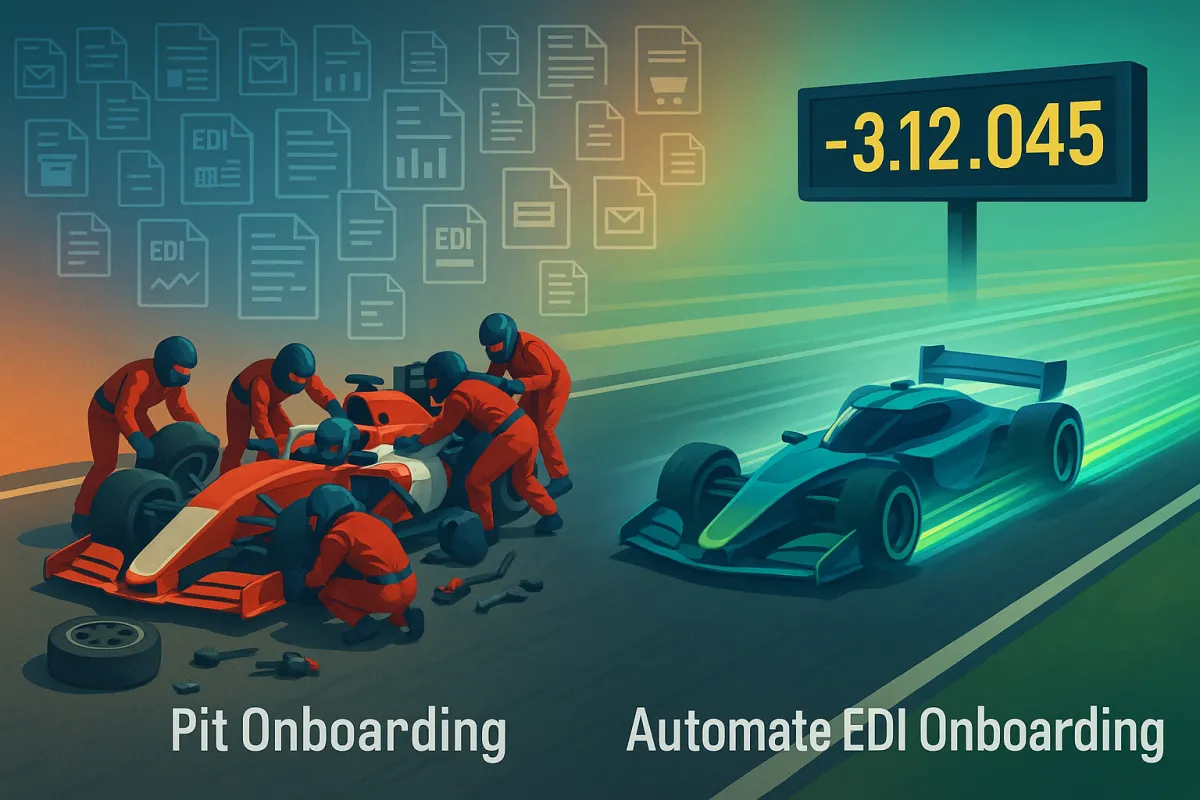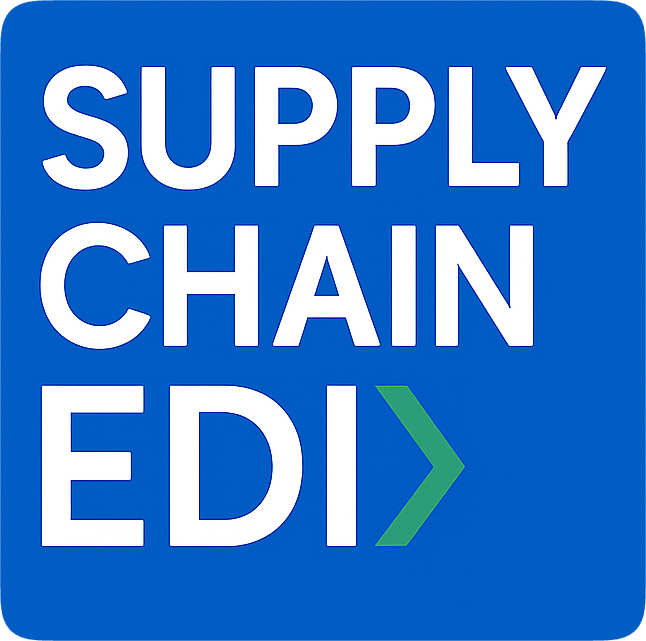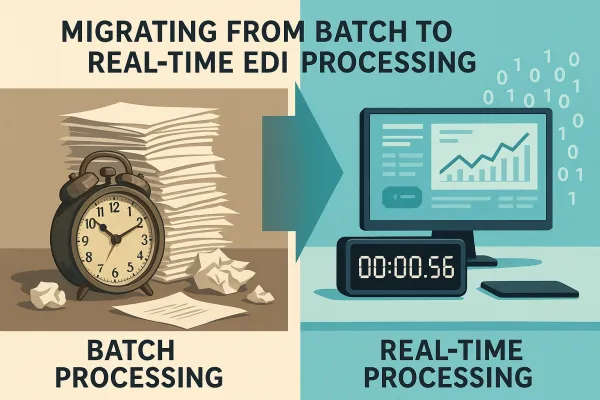The Complete Guide to Automated EDI Partner Onboarding: From 3-Month Delays to Same-Week Integration in 2025

Most EDI implementations today take months rather than days. Your suppliers wait four to six weeks just to get onboarded with traditional EDI vendors, and in practice, the theoretical 1-2 week timeline often stretches to 1-2 months or longer. While you lose potential revenue every day those partnerships remain inactive, your competitors who've automated their onboarding processes are capturing those same opportunities in hours, not weeks.
This comprehensive guide shows you how to build automated EDI partner onboarding systems that compress traditional 3-month cycles into same-week integrations. You'll discover the essential components, implementation frameworks, and ROI measurements that make rapid onboarding not just possible, but consistently repeatable across your entire partner ecosystem.
The Hidden Cost of Traditional EDI Onboarding (And Why It's Killing Revenue Growth)
The numbers tell a stark story. Supply chain disruptions in 2024 led companies to incur financial losses averaging around 8% of their annual revenues, with integration delays playing a major role in these losses. But the real cost isn't just in the delays themselves - it's in the compounding effect of missed opportunities.
Consider what happens when a new partner wants to integrate. Traditional vendor-dependent processes create a backlog where customers tell us it can take four to six weeks to get a new partner onboarded, meaning you can't do business with that company until that process is done, or you have to do business in an old way. That "old way" means manual processes, higher error rates, and delayed payments - exactly what EDI was supposed to eliminate.
The Business Impact of Slow EDI Integration
The financial impact goes deeper than most executives realize. Transmitting payments and invoices via EDI has the potential to reduce the cost of a financial transaction by up to 90%, which could result in an average yearly saving of $117,000. Every month you delay onboarding a trading partner represents thousands in lost efficiency gains.
Manual processes during this delay period create their own costs. Companies report standard error rates of 5% for manual processes, increasing to 33% during peak seasons, with one study identifying $295K in three-year cost savings just from the dramatic reduction in errors eliminated by EDI automation. Meanwhile, your staff burns hours on data entry that could be automated instantly with proper onboarding systems.
The bottlenecks are predictable: Data mapping challenges arise because different systems use varying data formats, and if these discrepancies aren't mapped correctly, it can lead to costly errors like incorrect inventory or delayed shipments. Custom mapping requirements, manual testing cycles, and back-and-forth negotiations with partners stretch timelines indefinitely.
Essential Components of an Automated EDI Onboarding System
Modern automated onboarding systems reverse traditional workflows entirely. Instead of starting with technical specifications and working toward business integration, you begin with self-service partner portals that capture business requirements and automatically generate the technical configurations needed.
The foundation rests on four core components: pre-built template libraries, automated connection protocols, self-service partner interfaces, and real-time ERP integration. Each component must work seamlessly with the others - template libraries inform connection protocols, partner portals feed configuration data, and ERP integration validates business rules automatically.
Template Library Architecture and Management
Your template library becomes the engine that powers rapid deployment. Rather than building each integration from scratch, you maintain versioned templates for common document types across X12, EDIFACT, and industry-specific standards. Larger organizations like Walmart leverage integration technology to strengthen supply chain control, demanding new trading partners adopt and implement EDI as the base price of entry - but they accomplish this through standardized templates that new partners can adopt immediately.
Template management requires more than just storing document formats. Version control becomes critical when EDI standards can differ across industries and regions, and ensuring compliance, especially in global partnerships with multiple standards, can be challenging while staying updated on regulatory changes. Your system needs automated template updates, compliance checking, and rollback capabilities when standards change.
Smart template systems also learn from each integration. Machine learning algorithms identify which template variations work best for different partner types, industries, or geographic regions. Over time, your library becomes more precise at predicting which templates new partners will need based on their business profile.
Implementing Automated Testing and Validation Protocols
Traditional testing cycles consume weeks because they're manual, sequential, and error-prone. Automated testing flips this model by running comprehensive validation suites in parallel while partners complete their business setup.
Connectivity testing starts the moment a partner provides their technical specifications. Your system automatically attempts AS2, SFTP, or VAN connections, validates certificates, tests throughput, and confirms message delivery - all while the partner continues filling out business questionnaires. By the time they finish the onboarding portal, connectivity tests are complete.
Document validation goes beyond simple format checking. Proper data mapping ensures smooth, error-free EDI transactions, but automation takes this further. Your validation protocols check business logic, cross-reference product codes against partner catalogs, validate pricing structures, and simulate complete transaction flows including order acknowledgments, shipping notices, and invoice processing.
Integration with Modern TMS and ERP Platforms
The most sophisticated onboarding systems connect directly to your existing technology stack. Rather than creating another data silo, they become integration orchestrators that coordinate between your ERP, TMS, WMS, and accounting systems.
API-first architectures make this possible. Instead of point-to-point EDI connections, modern systems expose APIs that ERP platforms can consume in real-time. When transport management systems like Cargoson, MercuryGate, or Descartes need to exchange data with new carriers or logistics providers, they can leverage these same automation frameworks for rapid partner onboarding.
This integration approach also enables sophisticated data synchronization. Partner master data flows automatically between systems, transaction status updates in real-time, and exception handling routes issues to appropriate teams without manual intervention.
Step-by-Step Implementation Framework for Rapid Onboarding
Successful automated onboarding requires careful orchestration across four distinct phases. Unlike traditional waterfall implementations, this framework runs phases in parallel where possible, dramatically compressing timelines.
Phase 1: System Preparation (Week 1-2)
Configure your template libraries for target industries and document types. Establish API connections to ERP and TMS platforms. Set up automated testing environments and validation rulesets. Most importantly, create partner segmentation logic that routes different partner types through appropriate onboarding flows.
Phase 2: Portal Deployment (Week 2-3)
Launch self-service partner portals with industry-specific questionnaires. Implement automated document collection workflows. Configure approval routing for business stakeholders. Enable real-time status tracking so partners can monitor their progress through each onboarding stage.
Phase 3: Testing Pipeline (Week 3-4)
Deploy automated connectivity testing, document validation, and end-to-end transaction simulation. Monitor initial transactions carefully, with monitoring periods typically lasting 2-10 business days depending on transaction volume. Set up exception handling and escalation procedures for issues that require human intervention.
Phase 4: Go-Live and Monitoring (Week 4+)
Activate production transactions with comprehensive monitoring. Enable automated alerts for performance issues. Collect partner feedback through integrated surveys. Begin measuring KPIs including onboarding time, error rates, and partner satisfaction scores.
Partner Self-Service Strategies That Actually Work
Partner portals succeed when they eliminate friction rather than creating digital bureaucracy. The most effective designs guide partners through business questions first - what products they sell, which locations they ship from, their preferred communication methods. Technical specifications come later, often pre-populated based on business choices.
Smart questionnaire design reduces abandonment rates significantly. Progressive disclosure shows only relevant questions. Contextual help explains technical requirements in business terms. Real-time validation prevents partners from submitting incomplete information. Save-and-resume functionality lets busy operations managers complete setup across multiple sessions.
Advanced Automation Features: AI-Powered Mapping and Predictive Testing
The next generation of onboarding automation leverages artificial intelligence to handle the complex mapping challenges that traditionally required human EDI specialists. AI-driven data mapping will simplify integration by adapting to different formats automatically, reducing manual effort and improving accuracy.
Machine learning algorithms analyze partner business profiles, industry classifications, and technical requirements to predict optimal mapping configurations. When a new automotive supplier joins your network, the system automatically suggests mapping templates used successfully with similar suppliers, pre-configures likely data transformations, and identifies potential compatibility issues before testing begins.
Predictive testing represents another breakthrough. By analyzing historical onboarding patterns, AI systems can forecast which integration points are most likely to fail for specific partner types. This enables proactive testing of high-risk scenarios and automated fallback configurations when primary connections fail.
ROI Measurement and Success Metrics
Automated onboarding systems generate measurable returns across multiple dimensions. Companies experience benefits of $1 million over three years, with payback periods of fewer than three months and ROI of 372% when implementing comprehensive EDI automation.
Key performance indicators include: onboarding cycle time (target: 80% reduction from baseline), integration success rate (target: 95%+ first-time success), partner satisfaction scores, and internal resource utilization. Organizations report improving B2B transaction efficiency by at least 25% with automated EDI, executing millions of documents in near-real-time with accuracy and reliability.
Cost savings calculations should include: reduced manual labor, eliminated paper processing, fewer chargebacks from errors, faster payment cycles, and avoided opportunity costs from delayed partnerships. Most implementations see positive ROI within six months, with returns accelerating as partner volume grows.
Selecting the Right EDI Platform for Automated Onboarding
Platform selection determines whether your automation investment succeeds or becomes another expensive disappointment. Only 32% of industrial products companies indicate their operations technology investments had delivered expected results, often because they chose platforms optimized for traditional workflows rather than automation.
Evaluation criteria should prioritize: template library depth and industry coverage, API-first architecture for ERP integration, self-service partner portal capabilities, automated testing and validation features, and real-time monitoring dashboards. Legacy platforms that require custom development for each partner integration cannot deliver rapid onboarding regardless of marketing claims.
When evaluating vendors, examine their customer onboarding success rates. Leading platforms reduce onboarding times from weeks to hours with flexible, customizable self-service portals. Ask for specific metrics: median onboarding time, first-pass success rates, partner satisfaction scores, and post-implementation support requirements.
Major players like SPS Commerce, Cleo, and TrueCommerce offer established automation features, while newer entrants like Orderful focus specifically on rapid onboarding workflows. For transportation-focused implementations, specialized solutions like Cargoson provide deep integration with TMS platforms and carrier onboarding workflows optimized for logistics operations.
The platform you choose today will determine whether you're onboarding partners in days or still waiting weeks. Whoever can most quickly adapt to each communication and data requirement - whether EDI, non-EDI, or API - will separate themselves and earn new business. Choose automation platforms that eliminate bottlenecks, not create new ones.
Start your automated onboarding implementation by auditing your current integration timelines, identifying your highest-volume partner types, and piloting automation workflows with willing partners. The competitive advantage belongs to companies that can integrate faster than their competitors can respond.





